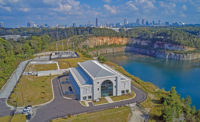Anticipating an influx of nearly three million new residents by 2050, the Atlanta Regional Commission has approved a $172.6-billion plan to address transportation needs across the 20-county metropolitan area.
Part of what the ARC calls “a long-range blueprint that details the investments, programs and services needed to ensure metro Atlanta’s future,” the plan calls for spending approximately $102 billion on maintenance and upgrades to existing infrastructure, including road and bridge repair projects, purchase of new transit vehicles and systems to support connected vehicles.
Another $27 billion worth of new highway and bridge construction would add toll lanes to top half of the I-285 Perimeter highway, and reconstruct several major interchanges on Atlanta-area interstates. More than 200 projects identified for the region’s arterial road network would add approximately 600 lane-miles of capacity.
The ARC plan also allocates $10 billion to expanding the region’s transit network. Suburban Clayton County would be evaluated for a new high-capacity transit line, along with the addition of bus rapid transit lines to replace existing conventional bus routes. Other projects include expanding Atlanta’s streetcar system and steps to prepare for construction of transit on other segments of the Atlanta BeltLine.
Alternative transportation strategies would receive $10 billion of funding under plan. Efforts would include expanding the region’s bicycle/pedestrian trails, supporting development of walkable neighborhoods and reducing peak hour demand on the highway and transit system by promoting options to conventional commuting habits.
ARC envisions funding for the plan to come from a combination of local, state and federal resources. Some of the major interstate and arterial widening projects are due to get underway in the coming decade using funding from a 2015 increase to Georgia’s fuel tax.
Atlanta is already the nation’s ninth-largest metropolitan area, with the U.S. Census Bureau data reporting a 2018 population of just under six million. Along with improving the safety and efficiency of the region’s transportation network, the ARC plan projects that the transit and congestion-reduction projects will reduce tailpipe emissions by 21,182 tons per year.





Post a comment to this article
Report Abusive Comment